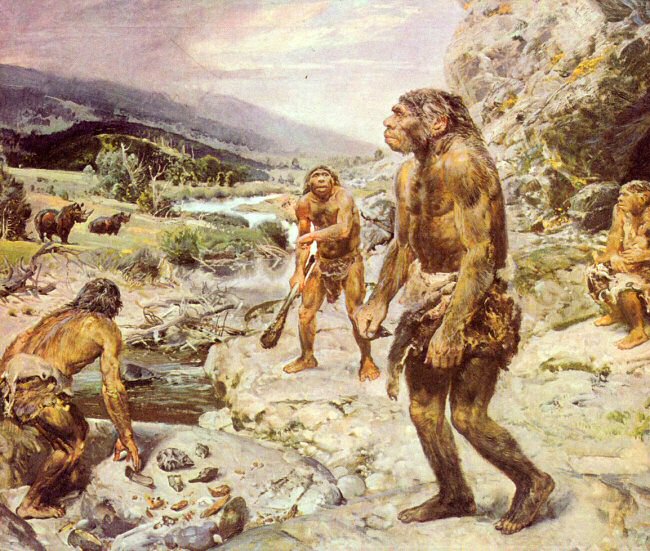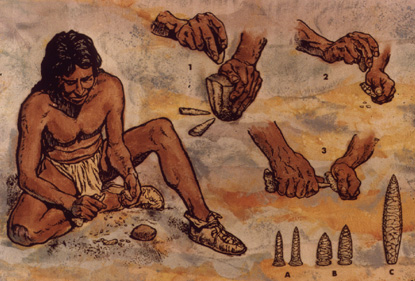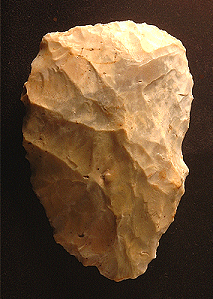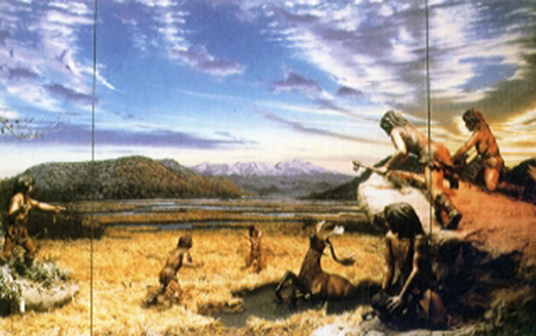The knowledge of the Palaeolithic social organization, especially Upper and Middle Palaeolithic are very scarce, and superficial. That is why stages, in which different forms of social lives were developed, are much more difficult to determine than the stages of human evolution. It is undisputed that the initial forms of coexistence and organization came from natural animal communities. First forms of social life, in which the human consciousness and intelligence matured, had to be the simplest and it had to have more in common with the family than with the extended human community.
The social community was, and still today is a necessity for the survival of man as an individual.
Without it, the human spiritual forces would never mature. For clarification of the social life beginnings, it can be used knowledge’s to which we came by comparing human habits with the habits of great apes. For example, the African gorillas and chimpanzees live normally throughout the year in related groups from 12 to 20 monkeys. One or more adult males are rulers of a group. There is no doubt that the period of helplessness, immaturity of man’s young descendants is very long. This period is of vital importance for the development of the community in general.
After Homo sapiens ancestors left the dense forest, and started to hunt on more opened terrain, after that followed a popularization of human groups. This led to an increased social cooperation. Each individual by living in trees was able to collect food, but just for him.
However, hunting of wild animals, especially if undertaken as a joint venture, was much more successful and far more useful for the wider human community, especially in terms of establishing and building relationships.



Archaeological materials show that at the beginning of the quarterly period, in some places, lived completely isolated group of people, and they lived on their own, in special life and work conditions. The most convincing evidence for this, is the mutual similarity of the oldest tools for work, found in France, Africa, China, Armenia, etc., which also explains the unity of the man origin, and human society.
Advances in the development of tools during the Lower and Middle Paleolithic were modest and not so great. Because of this, people who just separated themselves from the animal kingdom were not able to live or work separately, because constantly they were in danger of wild animals in whose environment they lived. Providing food, making tools, preserving of how to make tools and passing experience to the young generation is unthinkable without human collective. The most capable ones were, in any case, senior members of the human groups that usually performed as organizers of the work.



The first human groups numbered 20 to 40 people. They were called hordes. Living in hordes, man had inherited from its ancestors who were in half-animal state, helpless and rough towards forces of nature, and they did not know its own capabilities. Because of all this, paleolithic people were very poor and they were like animals, but they were slightly more productive than animals were. This life was far more similar to an animal life. Difficult and not favourable conditions of life, then a low level of productive forces development, and very low labour productivity influenced the emergence of cannibalism as well as the frequent mutual bloody battles that have occurred because of unregulated sexual relations within a horde. Therefore, it can be said that very primitive consciousness is a basic characteristic of every human member of the first human collective that was called hordes.
Hordes of an paleolithic people lived separately i.e. independently of each other, constantly wandering in search of food. From the very beginning, hordes were significantly different from monkeys, especially in terms of its compactness. Compactness was necessary to them for at least two reasons. First reason is due to the necessary collective protection of wild animals, and the second reason was joint conducting of activities.
An indispensable condition for human life in the horde was a work that in spite of all its shortcomings brought into the horde first elements of the organized economy. Regular working activity, depending on its complexity, brought very important and major changes in the relationships between members of the hordes.
In time, paleolithic people, in addition to plant food started to show an increasing need for meat food, so they gradually perfected the habits of collective hunting. Hunting, in relation, to collecting economy, engaged far more people for development of new tools, for developing of endurance and resistance, for stronger connection between members of the Hordes and a definitive separation of man from the animals.
The main characteristic of the period, when first human communities were developed, is greater unity of hordes and powerful connection of their members, which all together is a result of work. Hordes of Neanderthals usually numbered from 50 to 100 people. These were separate, environmental and production unit, which characterized the beginnings of permanent residence in one place, a common fireplace, and joint living quarters and at the end a collective work. That is how an people in Old stone age united and therefore made the horde more closed and isolated from other human groups.



One of the factors that had great influence on the formation and development of human community was related to the sex drive in men and in women. In the paleolithic period, human sexual relations were totally chaotic and mixed or as people usually say sexual relations were available to everyone.
At the time, sexual intercourse between man and woman was completely unregulated. Each woman belonged to every man and vice versa. This form of marriage relations was called promiscuity (promiscuus – blended, available to everyone) or a group marriage. Paleolithic people entered in marriage only with the members of the horde.
This is so-called endogamy or marriage within the same group. Marital relations were managed based on a biological instinct inherited from animals. There were not any marital restrictions between parents and children, brothers and sisters. Paleolithic people did not recognised blood relations, nor did they pay attention to blood relation.
With a later evolution of human consciousness, a new form of marriage relations have been created, so-called polygamy, i.e. marriage between one man and several women, and then monogamy, which is a marriage between one man and one woman. Evolution of the marital relationship has been developed side by side with practice of exogamy or marrying outside the group of an individual, or other social group. The habit of seeking a spouse outside of the main group, with time has become a custom, and later social and moral law. Those who did not abide by those laws were labelled as sinners and guilty people, and they were banned, based on that, out of the community.
Matriarchy – maternal authority, characterize the oldest period in the development of the first people community. It coincides with the period of so-called collecting economy in which women played a central role. She collected and prepared foods, and took care and raised children. She also took care of shelter-home, fire, clothes and so on. Woman was the centre of the humankind, the main pillar of the family. That is why relation between family members as well as the inheritance law went through the female line, because it was group marriage.



The term matriarchy, in the scientific terminology, was accepted conditionally, because woman and mother never had this kind of power in the family and society, which later, in patriarchy, achieved man. However, it is possible to say that her position, until patriarchy came to the scene, was the same, i.e. an equal to the position of man. Matriarchy was held until transition to a new branch of business, agriculture and cattle breeding. During that period, men took a leading role in ensuring food. At the same time, this is how new form of organization of society was established. This new form of society organization is called patriarchy in which the man – father had all the power in the family or wider community. Blood relation and the inheritance law solely went through father.
During the Middle Paleolithic period, there was a noticeable increase in the productive forces, and production relations, with this in regard came evident exogamy. All these positive developments have significantly influenced the transformation of the horde in the so-called higher family group whose main unit was gender or gens.
Gender is organized sociology-economic group of people. All descendants of one ancestor belonged to this group. The process of transformation of the first horde into gens went quite slowly. Namely, the creation of the gender preceded the creation of clans in which the origin was observed from the mother’s line. One gens had minimum 6 people and about maximum 60 people. Increased awareness of blood relation has grown not only based on physical, but also economic and social unity of the community, or gender. All damage and deleterious effects of mixing blood has finally been surpassed with development of gender. Almost without exception, the clans and genders are exogamous, while marriage within them was considered incest.
Sometimes the choice of a husband or wife was closely confined on to the young man and woman of a special relative group within the relevant clan. Collective work dominated in every gen. Settlements that were built near the hunting grounds point out, among other things, to the conclusion that there was a so-called tribal territory. Tribal territory was essential to economic activity, such as hunting and gathering of plant products. All members of the tribal community had an access to the results that were achieved by working together.
